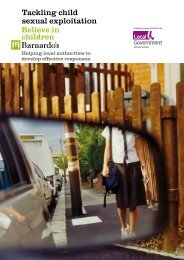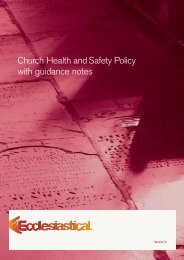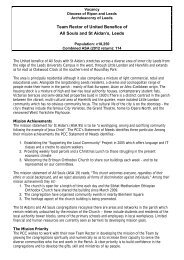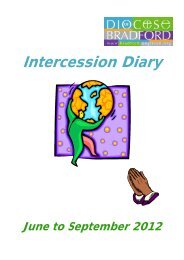Greengates - The Diocese of Bradford
Greengates - The Diocese of Bradford
Greengates - The Diocese of Bradford
You also want an ePaper? Increase the reach of your titles
YUMPU automatically turns print PDFs into web optimized ePapers that Google loves.
DEPRIVATION AND KEY ISSUES AFFECTING PARISHIONERSYou parish can be categorised as in the most or least deprived 10% or 50% <strong>of</strong> all parishes within the diocese and <strong>of</strong> all parishes nationallyDeprivation Indicator Score Diocesan Position National PositionLife Expectancy at birth (boys) 6 (1999-2003)7650% least deprived 50% most deprivedLife expectancy at birth (girls) 6 (1999-2003)8050% most deprived 50% most deprivedLife expectancy at birth can give an idea <strong>of</strong> overall quality <strong>of</strong> life. Life expectancy is an average. Women tend to have greater life expectancy. Life expectany can be affected by family history, marital status, economic status,physique, exercise, diet, drug use including smoking and alcohol consumption, disposition, education, environment, sleep, climate, and health care.15Research&StatisticsProportion <strong>of</strong> the population aged 60+ who are in receipt <strong>of</strong>the Guaranteed part <strong>of</strong> Pension Credit 5 (2012)29% 50% most deprived 10% most deprivedPension Credit is an income related benefit made up <strong>of</strong> 2 parts - Guarantee Credit and Savings Credit. <strong>The</strong> guaranteed part tops up weekly income if it’s below £142.70 (single people) or £217.90 (couples) so those whoreceive this are on a low income. This statistic only covers people living in private households, and not residential institutions (such as nursing homes).Percentage <strong>of</strong> working age persons (16-74) with noqualifications 2 (2011)Percentage <strong>of</strong> Children under 16 in Poverty 7 (2010)Index <strong>of</strong> Multiple Deprivation (IMD) 8 (2010)Proportion <strong>of</strong> the working age population who are in receipt<strong>of</strong> a key out-<strong>of</strong>-work benefit 5 (2012)Social rented as a percentage <strong>of</strong> all households 2 (2011)Lone Parent Households as a percentage <strong>of</strong> all householdswith children 2 (2011)29% 50% most deprived22%28.920%50% most deprived50% most deprivedA low-level <strong>of</strong> skill or educational attainment is one indicator <strong>of</strong> social disadvantage. Qualifications may make it easier to find employment. Learning also helps promote active citizenship and combat social exclusion.50% most deprived<strong>The</strong> proportion <strong>of</strong> children in families in receipr <strong>of</strong> either out <strong>of</strong> work benefits or tax credits where their reported income is less than 60% median income. Poor children may be excluded from participating in society. <strong>The</strong>y may be unable to afford schooltrips and activities; school uniforms or warm winter clothes, be unable to go swimming, have friends round for tea or celebrate their birthdays. Many will never have a holiday. Children who grow up poor are more likely to leave school withoutqualifications, have lower employment chances, thus restricting their ability to get a good job and financially contribute to society.Deprivation is considered to be a multi-dimensional problem, encompassing a range <strong>of</strong> domains such as financial, health, education, services or crime. continuous measure <strong>of</strong> relative deprivation therefore there is no definitive point on the scale belowwhich areas are considered to be deprived and above which they are not.While being in the most deprived 10% may indicate financial disadvantage, it could equally be due to isolated living.11%Number <strong>of</strong> people aged 16 to State Pension age claiming: Jobseeker’s Allowance (JSA), Employment and Support Allowance (ESA), Incapacity Benefit (IB), Income Support (IS) (as a lone parent or in the “other” category),Other income related benefits.Social housing is housing that is let at low rents and on a secure basis to people in housing need. It is generally provided by councils and not-for-pr<strong>of</strong>it organisations such as housing associations. Vulnerable groups are <strong>of</strong>tenconcentrated in the social housing sector, with low rates <strong>of</strong> employment and low income levelsChildren in single parent families have a much higher risk <strong>of</strong> living in poverty than children in couple families. Single parents may rely on informal childcare.29%50% most deprived50% most deprived10% most deprived10% most deprived50% most deprived50% most deprived50% most deprived50% most deprivedWhat are the particular issues that affect your parish? Are you doing anything to address these?








